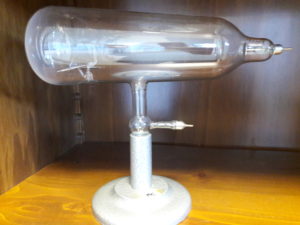
IT – Questo tubo fu inventato dal fisico inglese W. Crookes a fine ‘800 per dimostrare che i raggi catodici (termine coniato da Crookes per indicare quelli che saranno gli elettroni) si propagano in linea retta e rappresenta la base su cui si svilupparono gli schermi televisivi. Esso ha forma troncoconica e al suo interno si trovano: un gas a bassissima pressione, un elettrodo costituito da un disco in alluminio (catodo), un elettrodo costituito da una punta in alluminio (anodo) e una lastra di alluminio a forma di croce di Malta, che può essere tenuta in posizione verticale o orizzontale. Collegando gli elettrodi ad un generatore di tensione, nel caso di croce in posizione verticale, gli elettroni vengono accelerati dal campo elettrico e quelli non intercettati dalla croce, viaggiando in linea retta, colpiscono il fondo del tubo creando una zona luminosa (per eccitazione degli atomi del vetro) al cui interno rimane l’ombra della croce.
GB – Crookes tube with Maltese cross – This tube was invented by the English physicist W. Crookes at the end of the nineteenth century to prove that the cathode rays (term coined by Crookes to indicate electrons) propagate in a straight line and represents the basis on which television screens developed. It has a truncated cone shape and inside it there is a gas at very low pressure, an electrode consisting of an aluminium disk (cathode), an electrode consisting of an aluminium tip (anode) and an aluminium sheet in the shape of a cross of Malta, which can be kept in a vertical or horizontal position. By connecting the electrodes to a voltage generator, the electrons are accelerated by the electric field. Those which are not intercepted by the cross (in a vertical position) and which are traveling in a straight line strike the bottom of the tube, creating a luminous zone (from excitation of the atoms of the glass) inside of which appears the shadow of the cross.